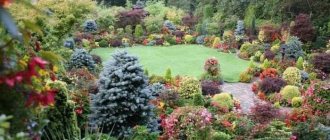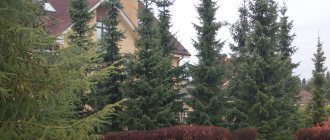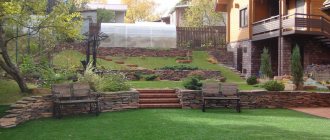Author: Elena N. https://floristics.info/ru/index.php?option=com_contact&view=contact&id=19 Category: Garden plants Published: February 14, 2019Last edits: October 24, 2021
- Growing conditions
- Reproduction by root suckers
- Beneficial features
Japanese Chaenomeles (lat. Chaenomeles japonica), or Japanese quince , is a species of flowering dicotyledonous plants of the Chaenomeles genus of the Rosaceae family. The species is native to Japan, although the plant is also widely grown in China and Europe. The generic name is literally translated from Greek as “split an apple.”
Planting and caring for chaenomeles
- Flowering: abundant, in May-June for three weeks.
- Planting: in spring, before sap flow begins, and in autumn, during leaf fall.
- Lighting: bright sunlight.
- Soil: rich in humus, light – sandy loam, loamy or soddy-podzolic, slightly acidic – pH 6.5.
- Watering: after planting - frequent and plentiful, especially during dry periods. In the future, regular but moderate.
- Fertilizing: after planting, fertilizing will be needed only after a year: in the spring, a bucket of compost, 100 g of potassium fertilizer and 300 g of superphosphate are added to the tree trunk circle. In summer, quince is fertilized with ammonium nitrate or mullein.
- Pruning: sanitary cleaning and formative pruning are carried out in early spring, before sap flow begins. When the bush reaches eight to ten years of age, it undergoes anti-aging pruning.
- Reproduction: seeds, root suckers, grafting and cuttings.
- Pests: scale insects and spider mites.
- Diseases: cytosporosis and ramulariasis.
Read more about growing Chaenomeles below.
How to choose a landing site?
Decorative quince blooms beautifully in well-lit places, but if there is no access to sunlight to the tree, it will develop weakly and bloom less beautifully. The soil should be moderately moist. Quince is more resistant to drought, but an abundance of water will not do it any good.
The quince tree takes root well in different types of soil, but it prefers an abundance of humus in the soil. The presence of peat is undesirable - because of it, the quince may not immediately take root in the new area.
When choosing a place in the garden, you should stay on the south side of the garden or find a place where the tree will be protected from wind and frost.
Please note that the rhizome of a tree can grow greatly and take up several meters, so choose a place where there are no other trees or buildings within 2-3 meters near it.
Botanical description
Japanese quince chaenomeles is a densely leafy shrub up to 3 m high with a dense crown of the same diameter. Young shoots of the plant are green, scaly-felt, then they become bare and black-brown. The leaves of Japanese quince are spatulate or obovate, narrowed towards the base, with blunt-toothed edges, 3 to 5 cm long and 2 to 3 cm wide. When young they are bronze, but the mature leaves of the plant are dark green. Pink, scarlet-red or orange flowers up to 5 cm in diameter are collected in 2-6 pieces in corymbose inflorescences. The round-shaped yellow-green edible fruits of Japanese quince with a diameter of up to 6 cm ripen by mid-autumn.
Planting and caring for quince in open ground
The plant has been in cultivation since 1874. The Japanese quince bush grows very slowly. The plant is thermophilic, but despite this it is able to withstand frosts down to -30 ºC, although at this temperature its annual shoots and flower buds that are above the snow level freeze slightly. Therefore, Japanese quince in Siberia may not bloom as luxuriantly as Japanese quince in the Moscow region or Japanese quince in the Urals. However, this crop is grown even in places with harsh climates.
Quince processing. Common quince
Common quince
Its frost resistance is lower than that of apple and pear trees; it successfully grows and bears fruit in the presence of average annual temperatures from 6.7 to 9°. It is moisture-loving, not demanding of location and soil, prefers moist, clayey soil with an admixture of sand.
Planting and care Quince varieties are mostly self-sterile, so for normal fruiting it is necessary to provide for the joint planting of several zoned varieties that can pollinate each other. Quince is propagated by grafting, layering, and seeds, but mainly propagation is carried out by layering. To do this, grooves with a depth of 15-20 cm are made near the mother tree at a distance of 0.75-1 m. Well-developing annual shoots are laid at the bottom, they are pinned in places where they bend, after which the groove is covered with damp soil, and the tops of the allocated shoots are tied to a peg so that they develop vertically. Caring for layering involves loosening the soil and periodic watering. The main elements of the soil maintenance system in fruit-bearing quince gardens are: black fallow, short-term grassing and black fallow. Young quince trees respond well to fertilizer. After 2-3 years, 2-3 kg/m2 of manure should be added, and in intermediate years - nitrogen, phosphorus, potassium, 9-12 g of active principle per 1 m2. The main fertilizer is applied in the fall before autumn digging, nitrogen nutrition - in the first half of summer, phosphorus-potassium - in the second. Quince trees need water nutrition in both warm and cold seasons. With each watering, water should be given as much as it is needed to thoroughly moisten the entire layer of soil in which the main root system is located. Young trees are watered more often - 8-10 times, the intervals between waterings are 15-20 days. When pruning, all diseased and dying branches, as well as shoots growing inside the crown, are removed annually. Root shoots are removed regularly.
Planting Japanese quince in open ground
When to plant
Planting and caring for Japanese quince follows the general rules for growing garden shrubs. It is better to plant chaenomeles in open ground in the spring, before sap flow begins. Autumn planting of the plant is also possible, but it is less desirable, since the heat-loving chaenomeles may not have time to take root in a new place before the onset of frost. The best planting material is two-year-old Japanese quince seedlings with a closed root system, which are watered abundantly before planting. For seedlings with an open root system, you should carefully examine the roots, if necessary, soak them in water for several hours, and then remove rotten, dry and damaged roots.
- Peat – what is it, what is it for, when to add it?
How to plant
Chaenomeles is planted in well-lit areas, since in the shade it develops worse and does not bloom as profusely. The plant prefers soil rich in humus, but light - soddy-podzolic, loamy or sandy loam with a slightly acidic reaction (pH 6.5). Japanese quince tolerates peat soils less well. It is advisable to allocate a place for it, protected from winds and drafts, on the south or southwest side of the house. Keep in mind that Japanese quince does not tolerate transplantation very well, and it will have to grow for 50-60 years in the place you choose.
The soil for spring planting needs to be prepared in the fall: cleared of weeds, dug up with the addition of leaf soil and sand. For digging, peat manure compost is also added at the rate of 10 kg per m² and 40 g of phosphorus and potassium fertilizers per the same unit of area. For a single planting, dig a hole with a diameter of 50 cm and a depth of 50-80 cm, and also prepare a soil mixture by adding 1-2 buckets of humus, 500 g of ash, 300 g of superphosphate and 30 g of potassium nitrate to the fertile soil from the top layer removed when digging the hole. . In group planting, plants are placed at a distance of 80-150 cm from each other, and when planting a hedge, an interval of 50-60 cm is sufficient. If you intend to get a fruit harvest by autumn, then plant 2-3 different varieties nearby. One bush of Japanese quince produces an average of about 2 kg of fruit, but there are also productive years when you can harvest up to 5 kg from one plant.
Planting and caring for an apple tree in the garden
On the day of planting, a mound of soil mixture is poured into the center of the hole and the seedling is placed on it so that the root collar is flush with the surface. The remaining space of the pit is filled with fertile soil mixture. After planting, the surface is compacted and watered abundantly. The shoots of the seedling are shortened to 15-20 cm.
Inclusion in the menu for weight loss
Quince is often included in the diet. Due to the low calorie content, improved metabolism and digestion, the weight loss effect is achieved much faster. The high content of vitamins plays the role of additional support for the body during the diet.
The fruit can be included in the diet in its pure form, or decoctions and teas can be prepared from it. A short-term mono-diet is allowed, but it should not last longer than three days. During the diet, only puree from boiled or baked quince is consumed. To complete the taste, you can add a little pumpkin and dried apricots to it. Such a strict diet is only suitable for people with a completely healthy digestive system. A more gentle option is to eat baked quince instead of one of your regular meals.
Japanese quince care
Growing conditions
Growing and caring for Japanese quince is unlikely to seem like a difficult task. During the first time after planting, quince needs regular watering, this is especially important during dry periods. After watering, the soil around the plant is carefully loosened to a depth of 8-10 cm. At the same time, weeds should be removed. To retain moisture in the soil as long as possible, the trunk circle of Japanese quince, the size of the crown projection, is mulched with a layer of peat, pine nut shells, crushed bark or sawdust 3-5 cm thick.
Once you have applied fertilizer when planting in a hole, the plant will not need it for at least a year. From the second or third year of life, Japanese quince is fed with mineral and organic fertilizers in the spring: a bucket of compost, 300 g of superphosphate and 100 g of potassium fertilizer are poured into the trunk circle of each bush. During the summer, liquid fertilizing with a solution of ammonium nitrate (20 g of fertilizer for each bush) or mullein (3 liters of a ten percent solution for each plant) will not be superfluous.
In late autumn, you need to prepare Japanese quince for winter. The tree trunk circle is securely covered with a thick layer of dry foliage or spruce branches. Seedlings or rooted cuttings are covered with spunbond or lutrasil, and low-growing compact bushes are covered with wooden boxes or cardboard boxes.
Diseases and pests
Japanese quince gets sick in exceptional cases, when there is practically no care for it or under the influence of natural disasters, for example, in cool rainy weather, which provokes the activity of fungal infections, the development of necrosis and spotting. At this time, the plant can be affected by cytosporosis or ramularia: the leaves of the plant become brown, dry, and the color of the Chaenomeles bark changes. These diseases must be controlled with copper-based antifungal chemicals, but diseased branches and shoots must be removed and burned before treatment.
Among the pests for Japanese quince, scale insects and spider mites are dangerous, the appearance of which is easier to prevent than to get rid of them for a long time. The first preventive spraying with an acaricidal drug (Aktara, Aktellik, Karbofos and the like) is carried out before the buds open, and then re-treatment may not be necessary.
Use in cosmetology
In cosmetology, quince is used to improve the condition of skin and hair. The action is achieved due to the content of fruit acids, tannins, and vitamins.
For face
Quince-based face masks and lotions are especially useful for women with oily skin, freckles, age spots, and enlarged pores. To solve each problem, masks are prepared according to different recipes.
- From freckles. Squeeze the juice out of fresh fruit, dip a cotton pad in it and wipe your face. Due to fruit acids, freckles gradually lighten, excess fat is eliminated, and the skin becomes matte.
- From withering. Add a spoonful of quince juice, honey and vegetable oil to the beaten egg yolk. The mixture is applied to the face and washed off after 15 minutes.
- From wrinkles. Grate the quince on a fine grater, add egg yolk. The mass is evenly distributed over the face and left for 12–15 minutes.
- From oily shine. The quince is peeled, ground in a blender, and mixed with whipped egg white. The mixture is applied to the skin and washed off after 15 minutes.
- Toning lotion. Add two tablespoons of quince juice, a spoonful of glycerin and vodka to a glass of water. The lotion is thoroughly mixed and used to wipe the face in the morning and evening. Store the product in the refrigerator.
For hair
Quince leaves and seeds are mainly used to treat hair. The remedy is chosen depending on the problem that arises. The seeds and leaves are used for different purposes.
- Infusion of leaves. Rinsing with an infusion of leaves helps get rid of dandruff, strengthens hair, and gives a natural, beautiful shade to dark curls. To prepare the infusion, take 100 g of dry leaves per liter of boiling water. The product is infused for an hour, filtered, and rinsed with hair three times a week.
- Decoction of seeds. To eliminate excess oil in strands, prepare a decoction of a glass of water and a tablespoon of seeds in a water bath. Without waiting for complete cooling, rub the product into the scalp, put on a plastic cap, and wrap it in a towel. Leave for an hour, then wash off with warm water.
A useful procedure is rubbing the skin with a slice of fresh fruit. The acids in the juice act as a light peeling - they cleanse, refresh the skin, and increase tone.
Pruning Japanese quince
The Japanese quince shrub tolerates pruning well, and this makes it a most valuable plant for ornamental gardening. To avoid injury, wear thick gardening gloves when pruning.
Planting and caring for pears in the garden
In the spring, sanitary cleaning of the bush is carried out: shoots frozen in winter, dry, damaged and improperly growing are removed. Places of cuts thicker than 7 mm are treated with garden varnish. Formative pruning is also carried out in the spring, before sap flow begins, but the crown of the plant begins to form at the age of four to five: to prevent the bush from growing wider and thickening, part of the root shoots are cut out annually, leaving only 2-3 young offspring. The most valuable are shoots located horizontally at a height of 20-40 cm from the ground. Shoots growing vertically or creeping along the ground must be removed.
When the bush reaches eight to ten years of age and the annual growth of shoots decreases to 10 cm, it is necessary to carry out anti-aging pruning. First, the bush is thinned out, leaving only 10-15 strong shoots. Since the main fruiting occurs on three to four year old branches, you need to gradually cut out branches that are five or more years old, replacing them with young shoots from the root shoots.
Compatibility with other plants
Ideal plants for combination with quince are golden currants and barberries. Such ensembles are variegated and decorative, decorating the entrance to the garden, curved paths, and fences. In the Japanese garden it grows next to juniper and black pine. Planted in combination with peony and tulip. Such an ensemble, even after flowering, does not lose its decorativeness and beauty.
Creating an alpine hill, chaenomelis is adjacent to such plants as slate pine, juniper, thuja varietal, prickly spruce and dwarf spruce. When combining Japanese quince with heather, rhodendron, spirea, almond and other flowering shrubs, you must follow these rules:
- the color scheme of the combined shrubs must be different; in extreme cases, their flowering should not occur in the same time period,
- combining Japanese quince with tall plants, they are planted only at the foot, and chaenomelis to your taste,
- Creeping shrubs are decorated with medium-sized and tall ones.
Combining Japanese quince with sakura and apricot can not only diversify the city landscape, but also turn the estate into a blooming white and pink cloud. Filled with bloom and aroma, like the Garden of Eden. In a group with forsythia, mahonia, and thunberg barberry they create harmonious, beautiful compositions. Fruiting is possible only if there are several copies in the garden. Henomelis is a good honey plant and attracts bees to the garden.
Reproduction of Chaenomeles
Japanese Chaenomeles propagates by seeds, cuttings, root suckers and grafting.
Reproduction by root suckers
Chaenomeles produces abundant root shoots, due to which the bush gradually grows in width and at the age of twenty occupies an area of about 2 m². You can dig up and plant root suckers 10-15 cm long and about 5 mm thick with well-developed roots. One plant can produce 5-6 such offspring. The planted shoots are regularly watered, and the surface of the soil around the shoots is mulched with shavings, wood chips or humus. The disadvantage of this method of propagation is that the shoots growing from the tap root still have an underdeveloped root system, and they have to be grown.
- Clarkia: growing from seeds, planting and care
Growing from seeds
The generative method of propagation of Chaenomeles is the most reliable. Fresh Japanese quince seeds, with a germination rate of about 80%, are sown in the ground before winter, and in the spring they sprout vigorously. Two-year-old seedlings form long tap roots, so they need to be planted in a permanent place as early as possible.
If you were unable to sow the seeds before winter, put them in the refrigerator for stratification, where they will remain in a bag of wet sand for 2-3 months. In the spring, as soon as they hatch, they can be sown in the ground.
Propagation by cuttings
The advantage of propagating Japanese quince by cuttings is that this method preserves the varietal properties of the plant. Green cuttings are cut in dry, hot weather in early June. Each cutting should have 1-2 internodes, and on the lower cut there should be a heel (a piece of last year’s wood) up to 1 cm long. For successful rooting of cuttings, it is necessary to use growth stimulants - indolylbutyric acid or Kornevin. The cuttings are immersed with the lower cut into a substrate consisting of three parts sand and one part peat, at an angle of 45º according to a 7x5 cm pattern and kept under a transparent cap at a temperature of 20-25ºC. The roots of the cuttings grow in 35-40 days, then the cuttings are planted in a permanent place.
Chaenomelis grafting
Japanese quince is grafted in May using the improved copulation method. A varietal cutting is taken as a scion, and a seedling of the main species or other rosaceous crops is used as a rootstock. Eye grafting is carried out in July-August, during the second sap flow: a bud (eye) with a piece of bark (scutellum) is cut off from the middle part of the varietal shoot with a sharp knife. Then a T-shaped cut in the bark is made on the bark of the rootstock, its edges are folded back and a shield with a peephole is inserted under them. Then the bent edges of the bark of the T-shaped cut are pressed against the shield and the scion is tightly tied in this place so that the eye itself is not covered with a bandage. After 3-4 weeks, if you did everything correctly, the eye should take root. If next spring the new bud sprouts, the bandage is removed.
Collection and procurement of raw materials
Fruits, leaves and seeds are stored for future use. The leaves are collected in the summer, the fruits in the fall, when they are fully ripe. Slightly unripe fruits can be stored fresh for up to five months. There are three ways to prepare Japanese chaenomeles for the winter.
- Procurement of seeds. The seeds are removed from the fruit without washing and placed in a dryer. The optimal drying temperature is about 50˚C. The dried seeds are poured into a glass jar with an airtight lid. When stored cool, they do not lose their properties throughout the year.
- Preparation of leaves. It is better to dry the leaves outdoors. They are laid out in a thin layer on paper in a shaded, well-ventilated place. The finished raw materials are poured into glass jars and tightly closed with lids.
- Harvesting fruits. The fruits can be dried or frozen - in both cases they will retain their medicinal properties. Before drying, the quince cut into slices is poured with boiling water with the addition of a small amount of citric acid. Next, the water is drained, the pieces of fruit are lightly dried, and placed in a dryer or oven at a minimum temperature. Freezing does not require pre-processing - the pulp is cut, placed in a bag, and placed in the freezer.
When collecting raw materials, it is better to wear a damp gauze bandage. The leaves and fruits are covered with fine hair. When inhaled, it irritates the mucous membranes, causing coughing and discomfort in the nasopharynx.
Varieties of Japanese quince
There are so many varieties of Japanese quince that you could write a separate article about them, so we will introduce you only to the most popular of them:
- Nikolai is a low-growing and thornless variety of Ukrainian selection with a spreading crown, orange-red flowers and slightly lumpy round yellow fruits weighing 50-80 g;
- Gaillardi is an ornamental plant with salmon-orange flowers;
- Malardi is an ornamental bush with pink flowers with a white border along the petals;
- Likhtar is also a Ukrainian non-thorny variety up to 1 m high, characterized by winter hardiness. The flowers are orange-red, the fruits are yellow-green, slightly lumpy, round, weighing up to 100 g;
- Papella is an ornamental plant with yellow flowers with a pink border;
- Fascination is a Dutch variety up to 1 m high with thorny branches, large red flowers, round or ovoid green fruits weighing 50-60 g;
- Merlozi is a Belgian variety up to 2 m high with relatively prickly erect branches, large white flowers with pink stripes and irregular pear-shaped green fruits weighing 60-80 g;
- Umbilicata is a Japanese variety up to 2 m high with erect, relatively prickly branches, pink-red flowers and spherical fruits weighing up to 90 g;
- Crimson End Gold is an American selection variety up to 1 m high with thorny spreading branches, medium-sized dark red flowers and greenish-yellow ovoid fruits weighing from 40 to 80 g with blush and thin skin;
- Simoni is a French variety 1-1.5 m high with spiny spreading branches, large dark red flowers and small, greenish-yellow ovoid fruits weighing 40-50 g;
- Nivali is a French variety up to 2 m high with dense prickly branches, medium-sized white flowers and yellow round fruits weighing up to 80 g.
In addition to those described, such varieties of chaenomeles as Toyo Nishiki, Snow Queen, Rubra, Vitamin, Ellie Mossel, Pomaranchevy, Karavaevsky, Kalif, Nika, Citrine, Fragrant, Krasnoplodny and others are popular.
The best partners in creating compositions
Chaenomeles blooms in early spring, when there is still little grass and green foliage on the trees, so during the flowering period, neighbors are selected from among spring-flowering plants. Together with sunny yellow forsythia, blood-red currant, white-flowered serviceberry or ornamental plum, the result is an attractive accent in the garden.
A charming natural corner is created by annual or perennial flowers :
white Arabis Caucasian;- Siberian scilla;
- snow-white or lemon-yellow daffodils;
- yellow-violet violets.
They look great in company with the orange-scarlet flowers of Japanese quince:
- blue speedwells;
- forget-me-nots;
- bells;
- white tulips.
In autumn, Chaenomeles, densely covered with sunny yellow miniature apple fruits, is beautiful against the background of a group of low-growing coniferous plants:
- thuja;
- ate;
- juniper;
- mountain pine;
- evergreen deciduous shrubs - boxwood or mahonia holly.
Japanese quince in landscape design
Chaenomeles is rightfully considered one of the most beautiful ornamental shrubs: rich green leaves shimmering in the rays of the sun, massive bright flowers of various colors, amazing yellow-orange or greenish-yellow fruits that simultaneously resemble apples and pears... The main advantage of the plant is that that it remains attractive throughout the growing season, from spring to late autumn. And since the lifespan of the plant is several decades, the ornamental Japanese quince will decorate your garden for almost your entire life.
In landscape design, not only tall varieties of Chaenomeles are used: low Japanese quince, reaching a height of no more than 1 m, with arched branches covered in spring with a mass of flowers, is also incredibly attractive.
Chaenomeles japonica is widely used to form rocky gardens and hedges. It is grown both as a solo plant in a rock garden or on a spacious lawn, and in groups forming artistic or geometric compositions. A popular method of growing Japanese quince on a high trunk is done by grafting its cuttings onto a wild pear or mountain ash.
The plant goes well with dwarf spruce, slate pine and varietal thuja. Blooming Japanese quince looks spectacular next to daffodils and Carpathian bells.
Growing conditions
Quince is very easy to grow and has extremely small requirements.
The preferred soil for quince is as follows:
- fertile;
- moderately humid;
- the reaction is preferably neutral (pH 6-7);
- prefers heavy soils.
The bushes can cope with conditions in almost any location. They do not like saline and swampy soils. They do not tolerate areas where water remains for a long time during the growing season. The shrub reacts to stagnant water with a significant reduction in growth and disease.
On alkaline and dry soils, quince is susceptible to chlorosis associated with poor absorption of iron. Then acidification with sulfur or iron sulfate is recommended, but it is more effective to apply iron chelates to the soil or in the form of foliar feeding “on the leaf.”
For intensive flowering and fruiting, you need to provide good access to sunlight. The plant loves the sun, so it should not be placed on the north side of buildings or under tree canopies. Shrubs growing in the shade are sparse, poorly leafed, and produce few flowers.
The plant grows best in warm regions where the risk of frost is low. Quince should be given a warm, protected place. A shrub grown in good conditions produces a good harvest with excellent taste.
Properties of Japanese quince - harm and benefit
Beneficial features
The fruits of Japanese quince, as well as the products obtained as a result of their processing, contain a large amount of useful substances: vitamin C, vitamins B1, B2, pectins, which help remove heavy metal salts, trace elements of potassium, calcium and phosphorus from the human body.
The juice of ripe Japanese quince fruits has a diuretic, anti-inflammatory, immunomodulatory effect, and cleanses the walls of blood vessels from sclerotic plaques. Due to the sour taste caused by the high content of vitamin C in the fruit, the plant is called northern lemon. Japanese quince fruits contain several times more iron than pears and apples, so their use is indicated for anemia and exhaustion.
The fruits of Chaenomeles are used as an effective restorative, hemostatic, antioxidant, choleretic, diuretic and antiemetic agent, and decoctions, alcohol tinctures and aqueous infusions of Japanese quince have a tonic, antibacterial, antiulcer, astringent and diuretic effect. Aqueous decoctions of Japanese quince seeds are used in folk medicine as a laxative, enveloping and expectorant.
The pulp of Japanese quince fruits is rich in fiber, and when consumed regularly, constipation is cured, the functioning of the digestive organs is improved, in case of heart and kidney failure, excess water is removed from the body, and the symptoms of toxicosis during pregnancy are eliminated.
- Volzhanka: planting and care
Contraindications
Along with a huge number of advantages, Japanese quince also has some contraindications. Chinese doctors claim that the quince fruit is a strong allergen, so you can eat only one-fourth of this fruit at one time. Quince fruits, infusions, tinctures and decoctions of them are contraindicated for enterocolitis, pleurisy, stomach and duodenal ulcers, a tendency to allergic reactions and individual intolerance to the product. After eating quince fruits or its preparations, due to the high content of ascorbic acid in them, which corrodes tooth enamel, it is necessary to rinse the mouth thoroughly. The fuzz from the peel of the fruit is harmful to the vocal cords and causes a sore throat and cough, and the toxic seeds must be removed along with the seed pods before eating the fruit.
Composition and nutritional value
Japanese quince is indispensable for humans, as it contains a large amount of vitamins, micro- and macroelements, which are so necessary for the body. The table shows the content of nutrients (calories, proteins, fats, carbohydrates, vitamins and minerals) per 100 g of fruit.
| Nutrient | Quantity | Daily value for an adult |
| Calorie content | 48 kcal | 1684 kcal |
| Squirrels | 0.6 g | 76 g |
| Fats | 0.5 g | 60 g |
| Carbohydrates | 9.6 g | 211 g |
| Organic acids | 0.9 g | |
| Alimentary fiber | 3.6 g | 20 g |
| Water | 84 g | 2400 g |
| Ash | 0.8 g | |
| Vitamins | ||
| A | 167 g | 900 mg |
| Beta Carotene | 0.4 mg | 5 mg |
| IN 1 | 0.02 mg | 1.5 mg |
| AT 2 | 0.04 mg | 1.8 mg |
| WITH | 23 mg | 90 mg |
| E | 0.4 mg | 15 mg |
| RR | 0.2 mg | 20 mg |
| Niacin | 0.1 mg | |
| Macronutrients | ||
| Potassium | 144 mg | 2500 mg |
| Calcium | 23 mg | 1000 mg |
| Magnesium | 14 mg | 400 mg |
| Sodium | 14 mg | 1300 mg |
| Phosphorus | 24 mg | 800 mg |
| Microelements | ||
| Iron | 3 mg | 18 mg |
| Digestible carbohydrates | ||
| Starch | 2 g | |
| Mono- and disaccharides | 7.6 g | Max. – 100 g |
| Saturated fatty acids | 0.1 g | Max. − 18.7 g |
Quince is equal in ascorbic acid content to lemon











